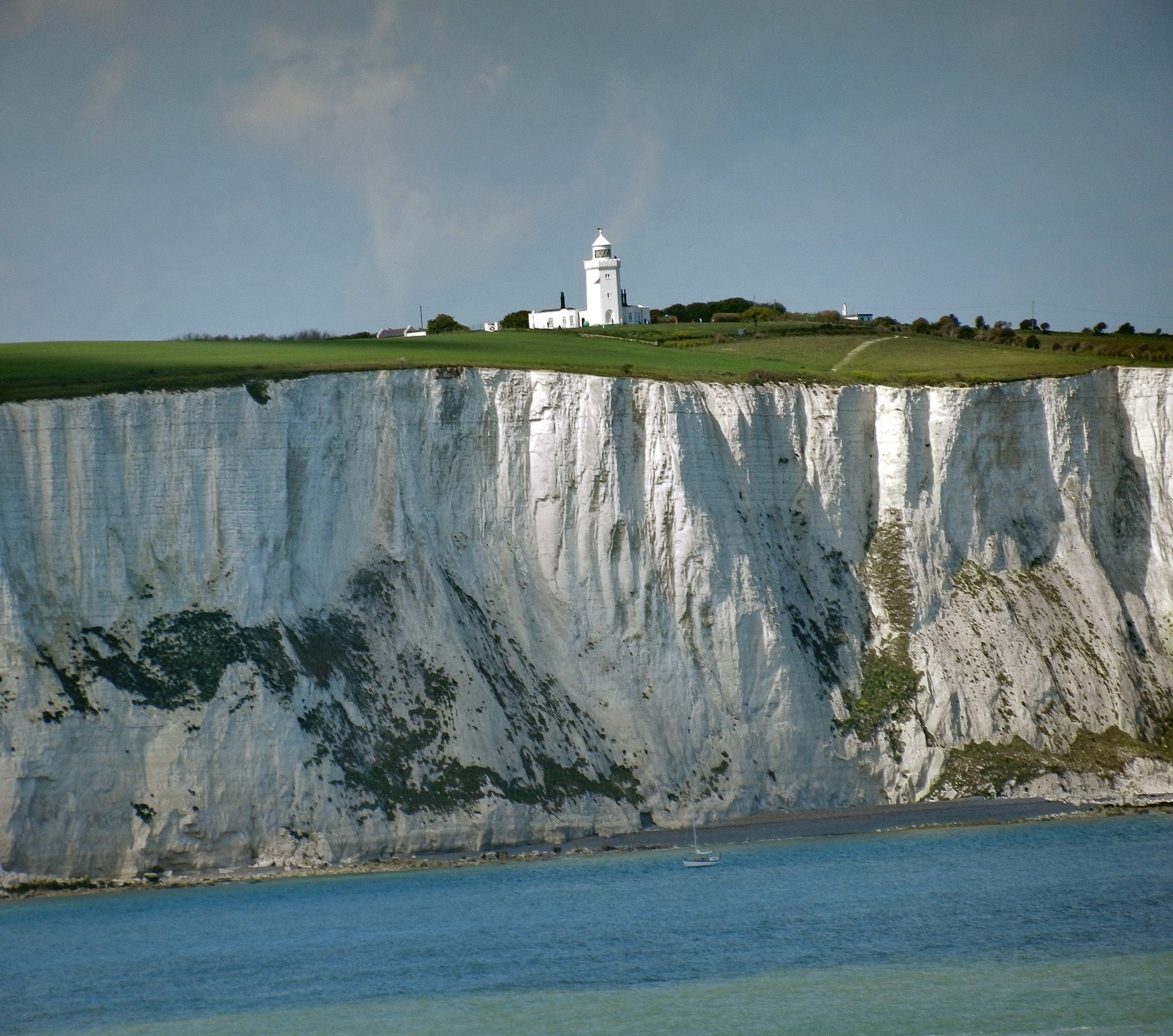
Credit: Tanya Dedyukhina, via Wikimedia Commons
The gleaming White Cliffs of Dover have dark seams of flint within them that were the target of some of Britain’s first mines—more than six thousand years ago.
The white cliffs are made of nearly pure chalk, the remains of phytoplankton, tiny floating algae.
These phytoplankton lived here in warm Cretaceous seas. When they died, their spherical bodies fell apart into the hard plates that covered them.
The microscopic plates, made of calcium carbonate, sank to the seafloor. There they formed a layer of white mud, at a rate of just half a millimeter per year.
But over 30 million years, that white sediment layer reached nearly two thousand feet thick. Its weight compacted it into the chalk we see today.
The main consumers of these floating algae were radiolarians, tiny zooplankton whose bodies were made not of calcium but silica.
Once they died, and were compacted for millions of years, the silica in their remains formed layers of flint in the chalk.
Though flint is a form of quartz, it’s nearly as hard as a diamond. It can be chipped to have very sharp edges, which Stone Age humans used to make blades and hunting points.
It was so valuable that Neolithic tribes would dig mine shafts down through the soft chalk to reach a strip of flint, then bring it to the surface to work into tools.
These mine shafts, and the tool making sites around them, may be Britain’s earliest industry and one of the reasons that human population grew here.
Background
Synopsis: The spectacular white cliffs along the coast of the English Channel have astounded explorers in the region for thousands of years. These vertical chalk faces are made up of the microscopic remains of phytoplankton that bloomed and died for more than 30 million years in Earth’s Cretaceous oceans. Silica-rich flint layers within the chalk drew Neolithic flint miners and tool makers to the region around 6,000 years ago, contributing to the early population of Britain.
- The English Channel formed in a series of catastrophic Pleistocene floods, as we described in a previous EarthDate episode (ED-084 Ice Age Brexit).
- Dramatic erosion left long reaches of stunning white cliffs exposed along the channel in southeastern England and northeastern France.
- One famous and photogenic British exposure is called the White Cliffs of Dover, reaching heights of 350 ft (110 m).
- Across the channel in France is the Alabaster Coast of Normandy.
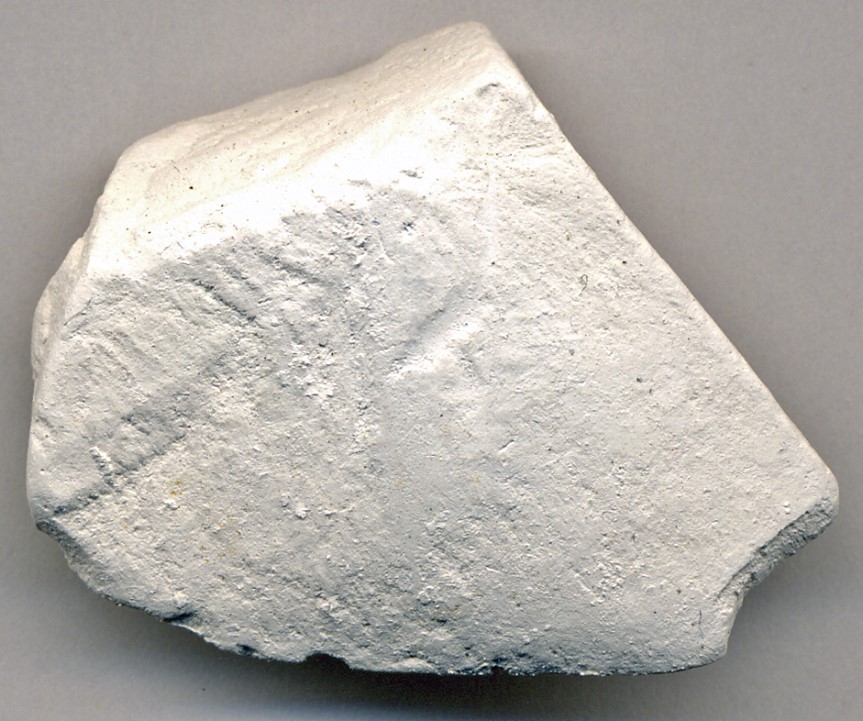
Chalk looks like a homogeneous white rock.
Credit: James St. John, via Wikimedia Commons
- These cliffs are made of chalk formations that accumulated throughout the Upper Cretaceous Epoch from about 100 million years ago to about 70 million years ago.
- In the seas that covered the region in the Late Cretaceous Epoch, single-celled photosynthesizing phytoplankton at the base of the food chain bloomed and died, just like they do today.
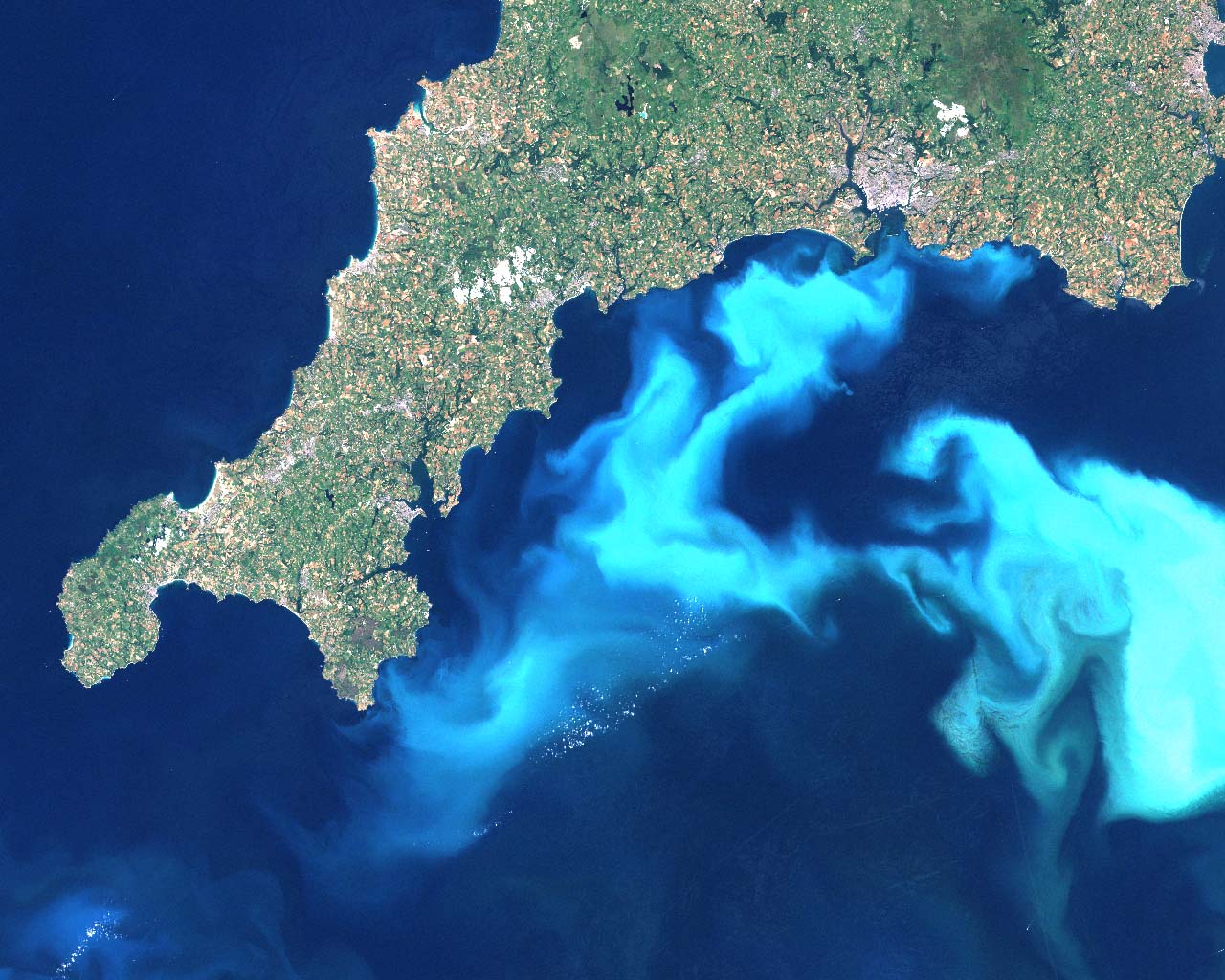
Under certain conditions, phytoplankton can form massive blooms which can be detected by satellite remote sensing. What looks like white clouds in the English Channel south of Plymouth, England, on this Landsat image, is the reflected light from billions of coccolithophores (Emiliania huxleyi) floating in the water column in July of 1999. Phytoplankton clouds like these would have been common in Cretaceous seas.
Credit: USGS, image courtesy of Steve Groom, public domain, via Wikimedia Commons - These coccolithophores disaggregated from their spherical shape into the protective disc-like coccolith plates that covered them as they rained down onto the seafloor at the rate of about half a millimeter per year.
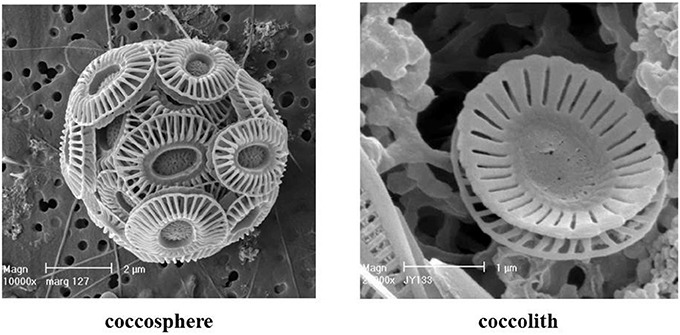
Scanning electron micrograph of Emiliania huxleyi (coccosphere and coccoliths). Scale bars are in microns (µm), for reference a human hair is about 150 microns in diameter.
Credit: Griet Neukermans and Georges Fournier (Dr. Jeremy Young, University College London, London, with permission), via Wikimedia Commons - For about 30 million years the white, muddy ooze accumulated, resulting in mud deposits as thick as 1,640 ft (500 m) that compacted into chalk as they were buried and finally folded upward during the Alpine orogeny.
- The Creta- in Cretaceous is Latin for “chalk.” The warm Cretaceous seas encouraged algal blooms that formed more chalk than at any other time on Earth.
- In the seas that covered the region in the Late Cretaceous Epoch, single-celled photosynthesizing phytoplankton at the base of the food chain bloomed and died, just like they do today.
- While the phytoplankton coccolithophores in chalk are composed of calcium carbonate, distinctive stripes of black, silica-rich flint layers occur in upper layers of the chalk, especially in southeastern England.
- These flint layers formed by concentration of silica from siliceous radiolarian zooplankton skeletons and sponge spicules. Calcareous phytoplankton are the main prey of silicious radiolarians.
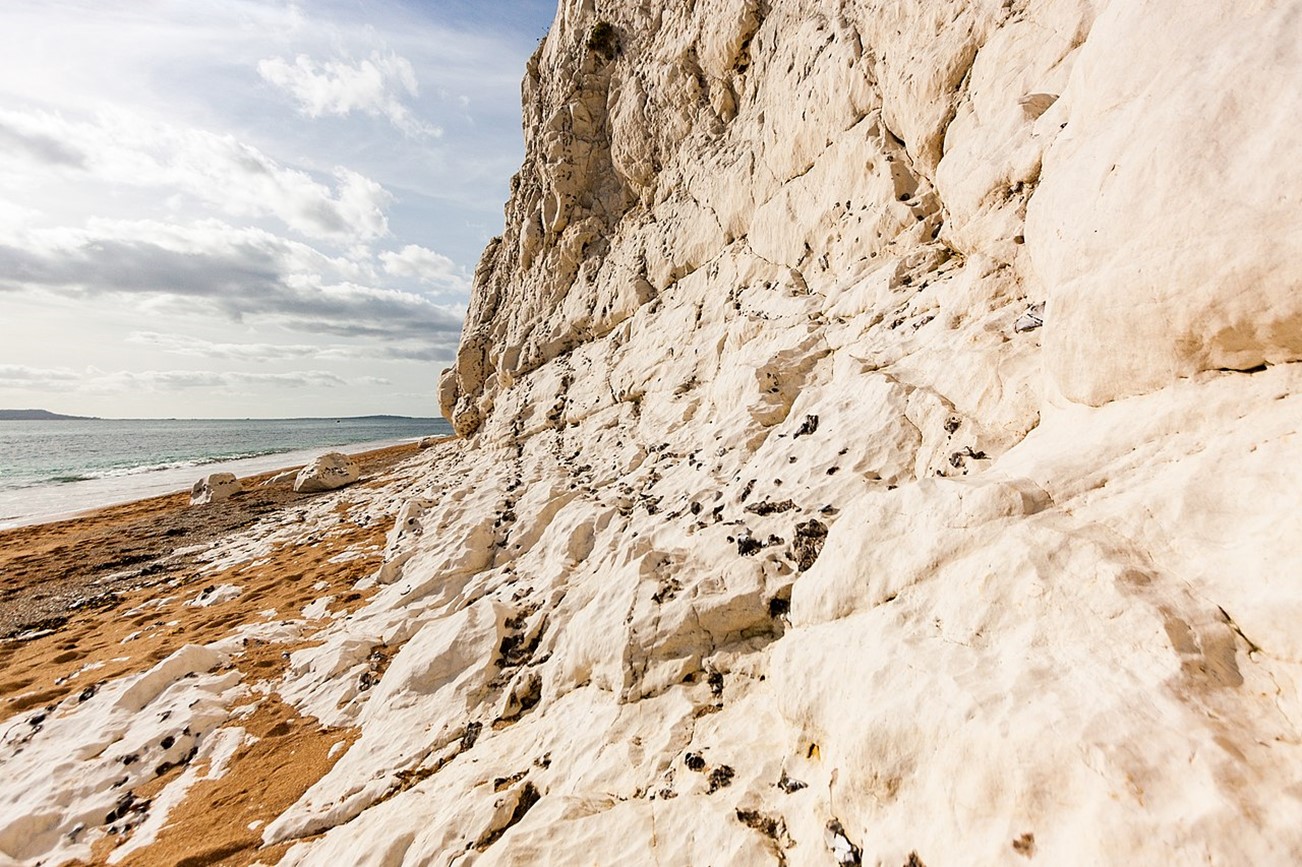
The chalk is striped with layers of flint that were mined by Neolithic tool makers.
Credit: Jan Kraus via Wikimedia Commons
- These flint layers formed by concentration of silica from siliceous radiolarian zooplankton skeletons and sponge spicules. Calcareous phytoplankton are the main prey of silicious radiolarians.
- Flint is microcrystalline quartz chert that is very hard, dense and durable.
- Stone Age civilization depended on flint for tools and weapons.
- It breaks with a curved (conchoidal) surface, and, if knapped so two or more surfaces intersect, the result is a very sharp edge.
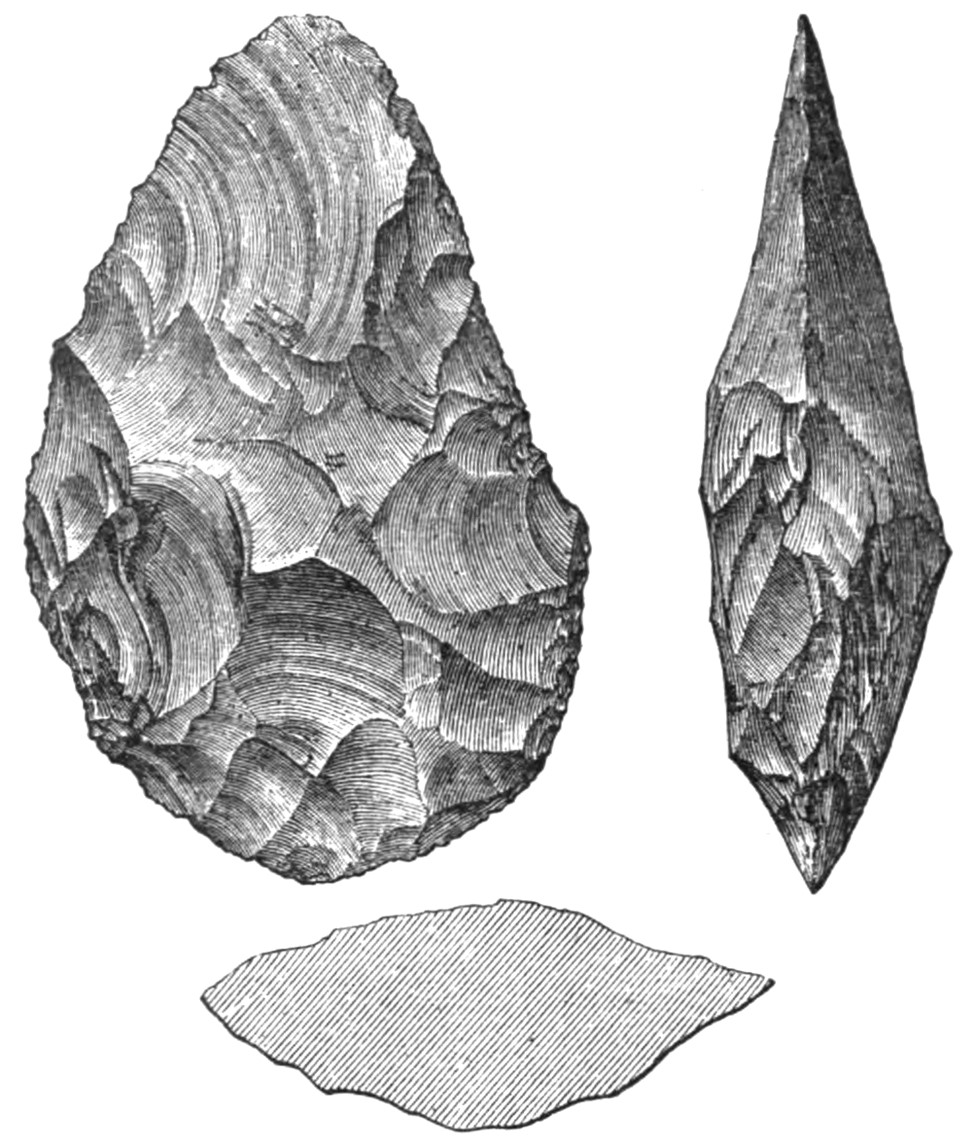
Flint axe from Hoxne in Suffolk (southeastern Britain), drawn by William Boyd Dawkins in 1880.
Credit: William Boyd Dawkins, public domain, via Wikimedia Commons
- Neolithic tool makers mined black flint from the chalk at as many as 70 sites in southeastern England from 4500 BC through about 3500 BC.
- On a hilltop near a site known as Cissbury Ring, 270 Neolithic mine shafts were developed over about 500 years that intersected with horizontal galleries that followed flint seams.
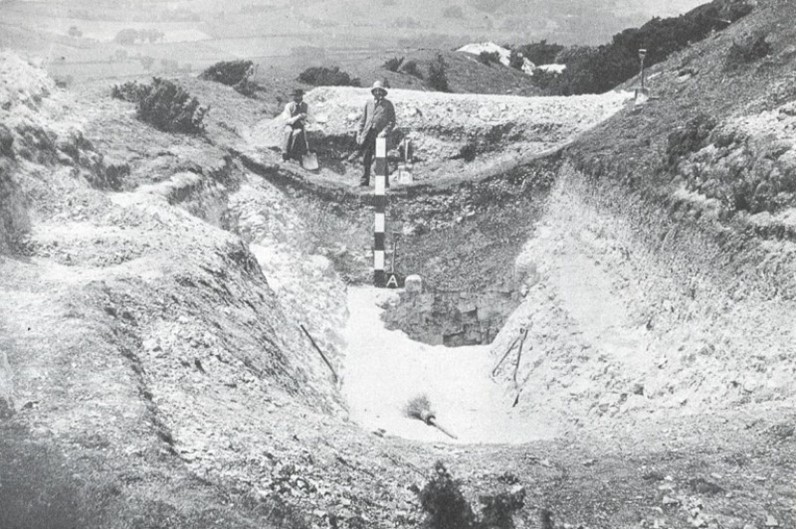
A Neolithic flint mine near Cissbury, England, was investigated and recorded in this very early archaeological photograph from 1875.
Credit: Bournemouth University
- On a hilltop near a site known as Cissbury Ring, 270 Neolithic mine shafts were developed over about 500 years that intersected with horizontal galleries that followed flint seams.

